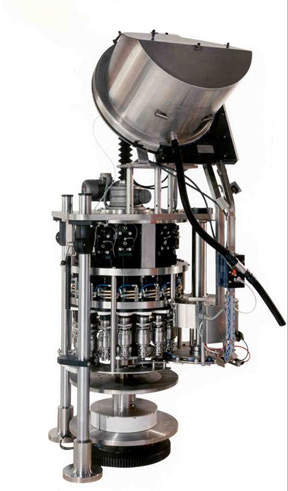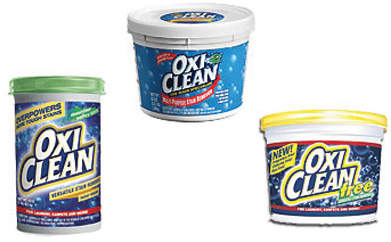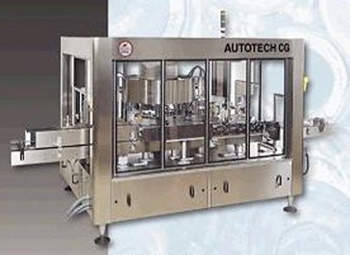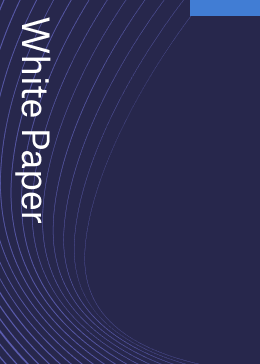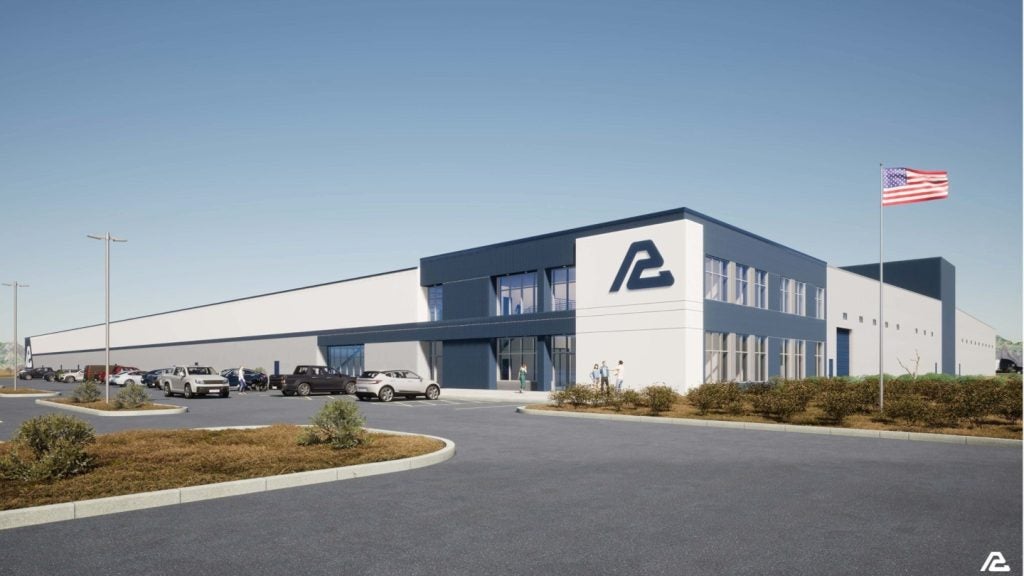APCO is a well known contract packaging company in the US that has carried out work for Orange Glo International since 1999. Orange Glo has always used contract companies to package their products since dedicated packaging facilities can be expensive to equip and run – the economics makes contracting the best and cheapest option.
In 2004, Orange Glo International wanted to consolidate the production of their range of OxiClean stain remover products to one site in the US. APCO Packaging Inc was chosen as their main partner and now packages over 80% of the Oxiclean products on the market in the US. This required some expansion at the APCO packaging facility in Bridgeview, Illinois; during 2004 the company restructured and installed two new packaging lines capable of running a wide range of packaging sizes for Oxiclean stain remover products. The granular Oxiclean is available in tubs with snap on lids in a range of eight sizes from 1lb up to 12lb.
APCO FACILITIES
APCO have four lines running the full range of product sizes, including two new lines that were installed in mid to late 2004. Richpak Machinery Inc were the consulting packaging engineers who suggested that new capacity was required at the facility to fulfill the new contracts and that equipment manufactured by All-Fill Inc was the best option to equip two new filling lines.
The first line has an 18-head continuous rotary filler at its centre that runs 3.5lb, 6lb, 9.25lb and 12lb containers at speeds ranging from 80 to 150 containers/min. The second line makes use of an intermittent-motion in-line filler that runs 1lb,1.5lb, 2.5lb and 8.5lb containers at 120 containers/min.
All-Fill carried out the installation, integration, testing, debugging and factory acceptance for the new equipment, both at its own site and when installed at the APCO facility. They were also responsible for training of APCO personnel in the use of the new equipment.
CONTAINERS
The containers used for the packaging are supplied by a number of plastic molding companies. The 1lb and 1.25lb containers (HDPE) are supplied by Schoeneck Container; the 2.5lb to 8.5lb containers (HDPE, polypropylene or copolymer PP) are manufactured by Berry Plastics Company and supplied through M Jacob and Sons; and the 9.25lb and 12lb containers (polypropylene) are supplied by IPL Inc. The 2.5lb to 12lb containers are usually printed by the manufacturers after they are made using a multicolor ultraviolet dry-offset printing process.
The IPL tubs have built-in tamper-evidence where the lid fits down inside a skirt which goes around the top of the container and can only be opened by removing the tear-strip. The 9.25lb and 12lb tubs also feature a skirt-hugging handle that doesn’t hang down and cause problems as the tubs go through the rotary filler.
ROTARY FILLING EQUIPMENT
The high-speed rotary filling line, which has the 18-head filler, runs six different plastic containers that hold from 2.5lb to 12lb of product. A dual denester from Del Packaging Inc places the tubs in two parallel rows on the in-feed conveyor supplied by Dorner Manufacturing Company. Stacks of tubs are loaded into vertical magazines and revolving feeders at the bottom separate individual tubs and drop them onto the conveyor in the required position. The machine cannot run the 9¼ and 12 lb tubs because of the attached handles, so these need to be manually placed on the conveyor.
The tubs are conveyed to the All-Fill rotary filler, where a helical feed screw meters them into the in-feed star-wheel of the filler which meters them into the filler turret. A sensor monitors containers on the conveyor to the filler and shuts down the process if no containers are present. The conveyor passes the front of the filler and picks up the filled containers as they are discharged from the filler.
COMPOUNDING AND CONTROL
A high-volume system meters the OxiClean components into a horizontal blender for compounding and mixing and from here the product is discharged into a large holding bin located next to the filler. A bucket elevator picks up the product from the bottom of the bin and lifts it into an overhead holding tank. The dry product then discharges into a 5ft³ hopper with dual augers that meter the product into the filler. A level control in the line from the holding tank into the hopper regulates in-feed into the hopper to maintain a consistent level for accurate filling.
Around the top of the rotating filler are 18 funnels that discharge product into the containers moving underneath. Sealing pads at the bottoms of the funnels sit on top of the tubs and create a tight seal for dust control. The open tops of the funnels travel beneath the two augers, which discharge product directly into the funnels. The proper weight of product in a container is achieved by coordinating the respective rotating speeds of the turret and the augers.
The filled tubs discharge through a star-wheel onto the same conveyor that delivered them to the filler. The filled tubs are then weighed using the All-Fill Alpha check-weigher which allows three weight zones; under, accept and over. Out-of-specification (OOS) tubs are rejected as they leave the check-weigher.
TUB SEALING AND LID PLACEMENT
Tubs pass beneath a scoop feeder from Palace Packaging Machines Inc and an insert placer from Del Packaging. The scoop feeder was designed for round scoops, and OxiClean has switched to square scoops, which the feeder cannot handle. It is being reworked to handle the square scoops. Two-page booklet-style top labels that contain the same information have replaced the inserts.
The tubs continue past a Videojet Technologies ink-jet printer that applies a code to the sides, after which the tubs go through a swinging arm that directs them into two lanes. The tubs then pass beneath lid applicators in which the lids are placed in inclined magazines. A magazine releases a lid that slides down an inclined chute and extends slightly over the path of the tub. As the tub passes beneath, it pulls the lid free and passes beneath a roller that presses the lid onto the tub. The removal of a lid triggers the release of the next lid.
LABELING AND PALLETIZING
The tubs then pass labelers from Quadrel Labeling Systems, which apply two-page top labels (booklets where a user can pull up the top page and read the instructions) to the lids. The roll of labels is mounted vertically, and the web of labels is pulled downward over a stripper plate where the label is removed from the web and applied to the lid. A brush mounted adjacent to the stripper plate brushes the label tightly to ensure good adherence. The labels are supplied by Lithoflex Co.
Many of the containers are then loaded directly onto pallets, but the smaller sizes are sometimes manually packed into corrugated shippers, that are pushed through a Little David top and bottom taper from Loveshaw before palletizing. Pallets are stretch-wrapped by equipment from Lantech.com, LLC.
IN-LINE FILLING EQUIPMENT
The other new packaging line runs 1lb, 1.5lb, 2.5lb and 8.5lb round containers on an All-Fill in-line filler. The filler uses two servo-driven augers in series. Both augers operate at the same speed, and each fills essentially half of the required amount of product into a container. Each auger discharges through a dividing head that splits the flow so that each one discharges into two containers simultaneously. Product is discharging into four containers simultaneously at each intermittent fill cycle.
Check weighing is carried out manually and the speed of the augers adjusted to maintain the required container weights. The containers travel to a six-head rotary capper from Fowler Products Co and enter the unit through an in feed screw and a star wheel. Caps are supplied by Phoenix Closures.
Containers leaving the capper travel through an induction-sealing unit from Enercon Industries Co to seal the aluminum foil on the insides of the caps to the tops of the jars and then pass a Videojet ink-jet printer which applies a product code.
The containers are then pressure-sensitive-labeled using a labeler from Multi-Tech Systems International, Inc with three Model 35PW p-s labeling heads – one top and two side units – from Accraply, Inc. Labels are supplied by Lithoflex Corp. After labeling, bottles pass a Marsh ink-jet printer from Videojet Technologies and then are manually cased, taped and palletized.

